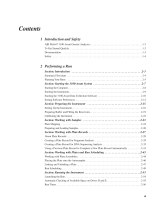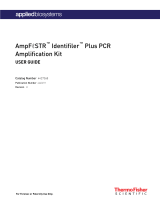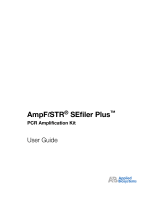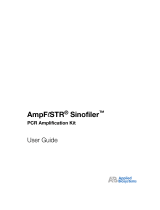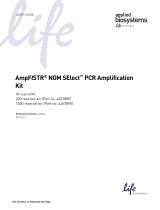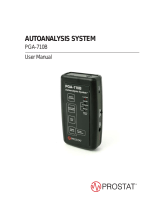
DRAFT
December 24, 2003 10:33 am, 4350218A.fm
User Bulletin
ABI PRISM® 3100/3100-Avant Genetic Analyzers
Using Data Collection Software v2.0
December 2003
SUBJECT: Protocols for Processing AmpFlSTR PCR
Amplification Kit PCR Products
In This User
Bulletin
This user bulletin includes the following topics:
Overview . . . . . . . . . . . . . . . . . . . . . . . . . . . . . . . . . . . . . . . . . . . . . . 2
About the Software . . . . . . . . . . . . . . . . . . . . . . . . . . . . . . . . . . . . . . 3
Materials Required . . . . . . . . . . . . . . . . . . . . . . . . . . . . . . . . . . . . . . 7
Safety. . . . . . . . . . . . . . . . . . . . . . . . . . . . . . . . . . . . . . . . . . . . . . . . 10
Procedure Flowchart . . . . . . . . . . . . . . . . . . . . . . . . . . . . . . . . . . . . 11
Prepare for the Run . . . . . . . . . . . . . . . . . . . . . . . . . . . . . . . . . . . . . 12
Perform a Spatial Calibration . . . . . . . . . . . . . . . . . . . . . . . . . . . . . 16
Perform a Spectral Calibration . . . . . . . . . . . . . . . . . . . . . . . . . . . . 22
Perform the Fragment Analysis Run . . . . . . . . . . . . . . . . . . . . . . . . 36
Data Collection Software v2.0 Verification Testing . . . . . . . . . . . . 46
How to Obtain Services and Support . . . . . . . . . . . . . . . . . . . . . . . 51
Appendix A: Previous Validation of the 3100 Genetic Analyzer . . 52
Appendix B: Previous Validation of the 3100-Avant Genetic
Analyzer . . . . . . . . . . . . . . . . . . . . . . . . . . . . . . . . . . . . . . . . . . . . . 58

DRAFT
December 24, 2003 10:33 am, 4350218A.fm
2 Protocols for Processing AmpF
l
STR PCR Amplification Kit PCR Products
Overview
This document describes:
• Protocols for processing AmpFlSTR® PCR Amplification Kit
PCR products on the ABI PRISM® 3100/3100-Avant Genetic
Analyzers
• Design changes and new features of ABI PRISM® 3100/3100-
Avant Genetic Analyzer Data Collection Software v2.0
• Procedures and important information for running
GeneMapper™ID Software v3.1 using Data Collection
Software v2.0
• Verification testing for Data Collection Software v2.0
• Previous validation of the 3100/3100-Avant Genetic Analyzers
Applicable
AmpFlSTR Kits
PCR products generated from any of the AmpFlSTR® PCR
Amplification Kits may be used with the 3100 and 3100-Avant
protocols described in this user bulletin.
Examples in This User Bulletin
Examples of results obtained using the AmpFlSTR PCR
Amplification Kits listed below are provided in this user bulletin.
The examples are shown in:
• Appendix A: “Previous Validation of the 3100 Genetic
Analyzer” on page 52
• Appendix B: “Previous Validation of the 3100-Avant Genetic
Analyzer” on page 58
Kit Dyes Matrix Standard Set
AmpFlSTR® Identifiler® PCR
Amplification Kit
•6-FAM
™
•VIC
®
•NED
™
•PET
™
•LIZ
®
DS-33
AmpFlSTR® Profiler Plus® PCR
Amplification Kit
•5-FAM
™
•JOE
™
•NED
™
•ROX
™
DS-32
AmpFlSTR® SGM Plus® PCR
Amplification Kit

DRAFT
December 24, 2003 10:33 am, 4350218A.fm
About the Software
Protocols for Processing AmpF
l
STR PCR Amplification Kit PCR Products 3
Recommenda-
tions
• When running the AmpFlSTR PCR Amplification Kits on the
3100 and 3100-Avant Genetic Analyzers, Applied Biosystems
recommends and supports the use of:
– 3100 POP-4™ Polymer
– 36-cm capillary array
–Hi-Di
™ Formamide
• To successfully run the AmpFlSTR PCR Amplification Kits on
the 3100 and 3100-Avant Genetic Analyzers, perform all of the
procedures listed/referenced in the flowchart on page 11.
About the Software
Data Collection
Software v2.0
Selected features of Data Collection Software v2.0 that pertain to the
workflow, troubleshooting, and data analysis information included in
this document are listed below.
Data Collection Software v2.0 includes:
• A new user interface
•New modules
– Modules that support AmpFlSTR PCR Amplification Kits
– An HID-specific module that includes recommended
injection parameters
• G5 Variable Binning Module (G5vb)
– Invoked through dye set selection
– Spectral pattern has been re-mapped
• Calibration changes
– Parameter files have been eliminated; settings are now edited
through the Protocol Manager
– Log files include more detailed descriptions of failure modes
Note: For a detailed description of Data Collection Software v2.0,
refer to the ABI PRISM® 3100/3100-Avant Genetic Analyzer User
Guide (PN 4347102).

DRAFT
December 24, 2003 10:33 am, 4350218A.fm
4 Protocols for Processing AmpF
l
STR PCR Amplification Kit PCR Products
GeneMapper ID
Software v3.1
Selected features of GeneMapper ID Software v3.1 that pertain to the
workflow and data handling information included in this document
are listed below.
GeneMapper ID Software v3.1 includes:
• Predefined panels and bin sets for each AmpFlSTR kit
• A Central Project window, which offers an interface between the
sample, genotype, and raw data views
• Plot settings that you can customize, which aids data evaluation
• Simultaneous analysis of multiple samples from different
AmpFlSTR kits, which improves workflow
• Automated concordance checks of controls and overlapping loci
from different AmpFlSTR kits, which eliminates manual
processing
Note: For a detailed description of GeneMapper ID Software v3.1,
refer to the GeneMapper™ ID Software v3.1 User Guide
(PN 4338775).
Data Collection
Software v2.0
and Fragment
Analysis
When GeneMapper ID Software v3.1 is installed on a computer that
has Data Collection Software v2.0, two applications are available
through the Results Group Editor:
• GeneMapper-<Computer Name> (where <Computer Name> is
the name of your computer)
When you use the 3100/3100-Avant Genetic Analyzers with
Data Collection Software v2.0 and the AmpFlSTR kits, Applied
Biosystems recommends that you use GeneMapper-<Computer
Name>.
• GeneMapper-Generic
GeneMapper-<Computer Name>
The GeneMapper-<Computer Name> application enables
autoanalysis. The Size Standard, Analysis Method, and Panel
columns in the Sample Sheet window read directly from the
GeneMapper ID Software v3.1 database.
IMPORTANT! You must create entries in these columns in
GeneMapper ID Software v3.1 prior to setting up the plate record for
a run. Once you are inside the Plate Editor dialog box in Data
Collection v2.0, you cannot create new entries in these columns. If
you create a new size standard, analysis method, or panel in
GeneMapper ID Software v3.1 while the Plate Editor dialog box is

DRAFT
December 24, 2003 10:33 am, 4350218A.fm
About the Software
Protocols for Processing AmpF
l
STR PCR Amplification Kit PCR Products 5
open, the columns will not be updated. The plate record must be
closed and reopened to update the entries. For information about
setting up size standards, analysis methods, and panels in the
GeneMapper ID Software v3.1 database, refer to the GeneMapper™
ID Software v3.1: Human Identification Analysis Tutorial
(PN 4335523).
GeneMapper-Generic
The GeneMapper-Generic application allows you to generate .fsa
files, but does not enable autoanalysis. When completing the Sample
Sheet, you need to fill in basic information for Data Collection
Software v2.0 to complete the run; all other fields related to
GeneMapper ID Software v3.1 are text entries.
The GeneMapper-Generic application is useful if you are:
• Using other software applications for analysis.
• Analyzing your samples in GeneMapper ID Software v3.1 on
another computer, but do not have the same entries in the
GeneMapper ID Software v3.1 database stored on the Data
Collection v2.0 computer.
For example, if you have a customized size standard definition
on the analysis computer, you can type that size standard name
in the Size Standard text field to populate that column in your
GeneMapper ID Software v3.1 project.
Performing
Autoanalysis
You may choose to perform autoanalysis of fragment analysis
samples by using features of Data Collection Software v2.0 and
GeneMapper ID Software v3.1.
You can only perform autoanalysis on the same instrument that
collected the sample files. To analyze samples on another computer,
you must transfer the files to that location.
If you perform autoanalysis on samples, but wish to edit/review
results on another computer, you need to:
• Transfer the GeneMapper ID Software v3.1 project, analysis
methods, size standards, panel, and bin set information to the
other GeneMapper ID Software v3.1 database. All components
need to be exported and imported individually.
Note: For import/export procedures, refer to the GeneMapper™
ID Software v3.1: Human Identification Analysis Tutorial
(PN 4335523).

DRAFT
December 24, 2003 10:33 am, 4350218A.fm
6 Protocols for Processing AmpF
l
STR PCR Amplification Kit PCR Products
• When completing the plate record, enter the Instrument Protocol
information for Data Collection Software v2.0 to complete the
run.
• When creating a new Results Group for a set of samples to be
autoanalyzed, check the Do Autoanalysis check box (and for
remote analysis, define a default location for sample file
storage).
Performing
Manual Analysis
For information on manual analysis, refer to the GeneMapper ID
Software v3.1 User Guide (PN 4338775).

DRAFT
December 24, 2003 10:33 am, 4350218A.fm
Materials Required
Protocols for Processing AmpF
l
STR PCR Amplification Kit PCR Products 7
Materials Required
The following tables list the materials required to run AmpFlSTR
PCR Amplification Kit products on the ABI PRISM 3100 and
3100-Avant Genetic Analyzers.
Dedicated
Equipment and
Supplies
Follow the guidelines for dedicated equipment and supplies to ensure
that exogenous DNA and PCR products are confined to a designated
area:
• Designate an amplified DNA work area for amplified DNA and
for dedicated equipment and supplies used to handle amplified
DNA.
• Applied Biosystems recommends that you do not remove
amplified DNA, equipment, or supplies from the amplified
DNA work area.
• Be careful not to let samples that are not amplified come into
contact with supplies and equipment in the amplified DNA work
area.
Accessories Accessories Supplier Part Number
3100 Capillary Array, 36 cm Applied Biosystems 4315931
MicroAmp® Optical 96-Well
Reaction Plate
Applied Biosystems N801-0560
96-well plate septa Applied Biosystems 4315933
Reservoir septa Applied Biosystems 4315932
Array-fill syringe, 250-µL glass
syringe
Applied Biosystems 4304470
Polymer-reserve syringe,
5.0-mL glass syringe
Applied Biosystems 628-3731

DRAFT
December 24, 2003 10:33 am, 4350218A.fm
8 Protocols for Processing AmpF
l
STR PCR Amplification Kit PCR Products
Chemicals Chemicals Supplier Part Number
3100 POP-4™ Polymer Applied Biosystems 4316355
Matrix Standard Set DS-32 for
3100 and 3100-Avant
(containing the dyes 5-FAM™,
JOE™, NED™, and ROX™)
Applied Biosystems 4323018
Matrix Standard Set DS-33 for
3100 and 3100-Avant
(containing the dyes 6-FAM™,
VIC®, NED™, PET™, and LIZ®)
Applied Biosystems 4323016
Hi-Di™ Formamide Applied Biosystems 4311320
GeneScan™-500 ROX™ Size
Standard
Applied Biosystems 401734
GeneScan™-500 LIZ® Size
Standard
Applied Biosystems 4322682
10X Genetic Analyzer Buffer
with EDTA
Applied Biosystems 402824
AmpFlSTR® PCR Amplification Kit, one of the following:
AmpFlSTR® COfiler® PCR
Amplification Kit
Applied Biosystems 4305246
AmpFlSTR® Identifiler® PCR
Amplification Kit
Applied Biosystems 4322288
AmpFlSTR® Profiler® PCR
Amplification Kit
Applied Biosystems 403038
AmpFlSTR® Profiler Plus® PCR
Amplification Kit
Applied Biosystems 4303326
AmpFlSTR® Profiler Plus® ID
PCR Amplification Kit
Applied Biosystems 4330284
AmpFlSTR® SEfiler™ PCR
Amplification Kit
Applied Biosystems 4335129
AmpFlSTR® SGM Plus® PCR
Amplification Kit
Applied Biosystems 4307133

DRAFT
December 24, 2003 10:33 am, 4350218A.fm
Materials Required
Protocols for Processing AmpF
l
STR PCR Amplification Kit PCR Products 9
Software GeneMapper ID Software v3.1 is required to analyze and genotype
AmpFlSTR PCR Amplification Kit products on the 3100 and 3100-
Avant Genetic Analyzers running Data Collection Software v2.0 or
later.
User
Documentation
When processing AmpFlSTR PCR Amplification Kit products on
the 3100 and 3100-Avant Genetic Analyzers, it may be helpful to
refer to the Applied Biosystems instrument, software, and kit
documentation listed below.
Document Part Number
ABI PRISM® 3100/3100-Avant Genetic Analyzer User
Guide
4347102
GeneMapper™ ID Software v3.1: Human Identification
Analysis Tutorial
4335523
GeneMapper™ ID Software v3.1 User Guide 4338775
AmpF
l
STR® COfiler® PCR Amplification Kit User
Bulletin
4305469
AmpF
l
STR® Identifiler® PCR Amplification Kit User’s
Manual
4323291
AmpF
l
STR® Profiler® PCR Amplification Kit User’s
Manual
402945
AmpF
l
STR® Profiler Plus® PCR Amplification Kit User’s
Manual
4303501
AmpF
l
STR® Profiler Plus® ID PCR Amplification Kit
User Bulletin
4330429
AmpF
l
STR® SEfiler™ PCR Amplification Kit User’s
Manual
4337410
AmpF
l
STR® SGM Plus® PCR Amplification Kit User’s
Manual
4309589

DRAFT
December 24, 2003 10:33 am, 4350218A.fm
10 Protocols for Processing AmpF
l
STR PCR Amplification Kit PCR Products
For More
Information
The procedures in this user bulletin provide a broad overview of the
steps required to perform a fragment analysis run and to perform data
analysis. For detailed reference information, refer to the following
documents.
• Shadravan, F., 2001, Sizing Precision and Reproducibility
Studies of AmpFlSTR® Kits with ABI PRISM® 3100 Genetic
Analyzer. Proc. Am. Acad. Forensic Sci. 7:26.
• Shadravan, F., Roby, R.K., Reeder, D.J., 2002, Characterization
of AmpFlSTR® Identifiler® PCR Amplification Kit for use with
ABI PRISM® 3100 Genetic Analyzer. Proc. Am. Acad. Forensic
Sci. 8:27.
• Daoudi, Y., Boland, C., Joe, L., Leibert, C., Wheaton, A., Roby,
R.K., 2002. Validation of AmpFlSTR® PCR Amplification Kits
for Use with the ABI PRISM® 3100-Avant Genetic Analyzer.
Proceedings from the 13th International Symposium on Human
Identification, in press.
Safety
Complete Safety information for the 3100/3100-Avant Genetic
Analyzers may be found in the ABI PRISM® 3100/3100-Avant Genetic
Analyzer User Guide (PN 4347102).

DRAFT
December 24, 2003 10:33 am, 4350218A.fm
Procedure Flowchart
Protocols for Processing AmpF
l
STR PCR Amplification Kit PCR Products 11
Procedure Flowchart
The flowchart below provides an overview of the procedures required
to run the AmpFlSTR PCR Amplification Kit products on the 3100
and 3100-Avant Genetic Analyzers. See the referenced section for
detailed procedures.
See
page 12.
Prepare for a run.
See
page 16.
If necessary, perform
a spatial calibration.
See
page 22.
If necessary, perform
a spectral calibration.
See
page 36.
Perform a fragment
analysis run.

DRAFT
December 24, 2003 10:33 am, 4350218A.fm
12 Protocols for Processing AmpF
l
STR PCR Amplification Kit PCR Products
Prepare for the Run
This section contains brief procedures to prepare for a run. For
detailed information, refer to the ABI PRISM® 3100/3100-Avant
Genetic Analyzer User Guide (PN 4347102).
Procedure
Flowchart
Start the
Instruments and
Software
Start instruments and software (below).
Prepare for a
run.
Prepare the 3100 instrument (page 13).
If necessary, replace the capillary array (page 13).
If necessary, add or change polymer (page 14).
If necessary, replace syringes (page 15).
To start the instruments and software:
1. Turn on the computer. The OrbixWeb™ Daemon software
automatically launches.
2. Turn on the 3100 or 3100-Avant Genetic Analyzer. Wait for
the green light to appear.
3. Start Data Collection Software v2.0:
Select Start > Programs > Applied Biosystems > Data
Collection > Run Data Collection 3100 v2.0 or Run Data
Collection 3100-Avant v2.0.
The Service Console displays; when all the applications are
running, the Data Collection Viewer window displays.
4. View and set preferences.
Service Console: When
all squares are green,
all the applications are
running. This could
take several minutes.

DRAFT
December 24, 2003 10:33 am, 4350218A.fm
Prepare for the Run
Protocols for Processing AmpF
l
STR PCR Amplification Kit PCR Products 13
Prepare the 3100
Instrument
Replace the
Capillary Array
When to Replace a Capillary Array
A capillary array should last approximately 100 runs. The following
indications may suggest that a new capillary array is required:
• Poor sizing precision or allele calling
• Poor resolution and/or decreased signal intensity
IMPORTANT! A run will not start without the correct spectral
calibration for a specific dye set and capillary array length. Refer to
the ABI PRISM® 3100/3100-Avant Genetic Analyzer User Guide
(PN 4347102) for procedures on setting the active spectral
calibration.
Replace the Capillary Array
To prepare the 3100/3100-Avant instrument:
1. Preset autosampler and place fresh deionized water and 1X
running buffer in positions 1 to 4.
CHEMICAL HAZARD. 10X Genetic
Analyzer Buffer with EDTA may cause eye, skin, and
respiratory tract irritation. Read the MSDS, and follow the
handling instructions. Wear appropriate protective eyewear,
clothing, and gloves.
2. Place lower polymer block and anode buffer jar on the
instrument.
3. Clean the capillary array detection window with methanol, if
necessary.
CHEMICAL HAZARD. Methanol is a
flammable liquid and vapor. Exposure causes eye and skin
irritation, and may cause central nervous system depression
and nerve damage. Read the MSDS, and follow the handling
instructions. Wear appropriate protective eyewear, clothing,
and gloves.
To replace a capillary array:
1. Use a 36-cm capillary array for the AmpFlSTR kits.

DRAFT
December 24, 2003 10:33 am, 4350218A.fm
14 Protocols for Processing AmpF
l
STR PCR Amplification Kit PCR Products
Add or Change
Polymer
2. Install the capillary array:
• Using the Install Capillary Array wizard
OR
• Using the Update Capillary Array Info utility
To replace a capillary array: (continued)
To add or change polymer:
1. Use 3100 POP-4™ Polymer (PN 4316355) for the
AmpFlSTR kits.
CHEMICAL HAZARD. POP-4
Polymer causes eye, skin, and respiratory tract irritation.
Read the MSDS, and follow the handling instructions. Wear
appropriate protective eyewear, clothing, and gloves.

DRAFT
December 24, 2003 10:33 am, 4350218A.fm
Prepare for the Run
Protocols for Processing AmpF
l
STR PCR Amplification Kit PCR Products 15
Replace the
Syringes
To maintain optimal performance, Applied Biosystems recommends
that syringes be replaced approximately every 3 months.
2. Use the table below to determine whether to add or change
the polymer before proceeding with instrument preparation.
IMPORTANT! Always replace polymer on the instrument
that is older than 1 week.
To add or change polymer: (continued)
If polymer on the instrument
is... Then ...
less than 1 week old, and
sufficient in quantity to complete
your runsa
ensure that there are no air
bubbles, and then proceed with
instrument preparation.
less than 1 week old, and
insufficient in quantity to
complete your runs
fill the syringes and the upper
polymer block with polymer by
following the Change Polymer
wizard.
more than 1 week old 1. Remove and clean the
polymer blocks and syringes.
2. Fill the syringes and the upper
polymer block with polymer by
following the Change Polymer
wizard.
wrong type (changing between
POP-6™ and POP-4™ polymers)
a. A 3100 run (16 capillaries) uses 50 to 80 µL of polymer and a 3100-Avant run
(4 capillaries) uses approximately 20 µL of polymer.

DRAFT
December 24, 2003 10:33 am, 4350218A.fm
16 Protocols for Processing AmpF
l
STR PCR Amplification Kit PCR Products
Perform a Spatial Calibration
When to Perform
a Spatial
Calibration
Perform a spatial calibration after:
• Installing or replacing a capillary array
• Temporarily removing the capillary array from the detection
block
• Moving the instrument
Procedure
Flowchart Perform a spatial calibration (page 17).
If necessary,
perform a spatial
calibration.
Accept or reject the spatial calibration (page 20).
Evaluate the spatial calibration profile to determine
pass/fail status (page 19).
Review evaluation criteria (page 18).
If the spatial calibration fails, perform
troubleshooting (page 21).

DRAFT
December 24, 2003 10:33 am, 4350218A.fm
Perform a Spatial Calibration
Protocols for Processing AmpF
l
STR PCR Amplification Kit PCR Products 17
Perform a Spatial
Calibration
To perform a spatial calibration:
1. In the Tree pane of Data Collection Software v2.0, click
GA Instruments >ga3100 or ga3100-Avant >
instrument name >Spatial Run Scheduler.
2. In the Spatial Protocols section:
a. Select one of the following:
– If the capillaries contain fresh polymer, select
Protocol >SpatialNoFill_1
– Otherwise, select Protocol >SpatialFill_1
b. Click .
Note: You do not need to fill the capillaries each time you
perform a spatial calibration.
Positions (pixel)
of each
capillary
Spatial profile
Start and Accept or
Reject Spatial profile here
Select one

DRAFT
December 24, 2003 10:33 am, 4350218A.fm
18 Protocols for Processing AmpF
l
STR PCR Amplification Kit PCR Products
Review
Evaluation
Criteria
While viewing the calibration profile, use the following criteria to
evaluate the data:
Passing profile from a 3100-Avant system
3. Click .
The calibration run lasts approximately:
• 2 min without filling the capillaries
• 6 min with filling the capillaries
Note: The spatial profile window turns black when you start
a spatial calibration.
To perform a spatial calibration: (continued)
Peak
Attribute Criteria
Height Similar heights for all peaks.
Shape Single sharp peak for each capillary.
Small shoulders are acceptable.
Spacing Position values are 13–16 higher than the
previous one for every capillary. Theoretical
spacing between capillaries is 15.
Orange crosses One orange cross marking the top of every peak.
No misplaced crosses.

DRAFT
December 24, 2003 10:33 am, 4350218A.fm
Perform a Spatial Calibration
Protocols for Processing AmpF
l
STR PCR Amplification Kit PCR Products 19
Passing profile from a 3100 system
Failing profile from a 3100 system
Evaluate the
Spatial
Calibration Profile
To evaluate the spatial calibration profile:
1. View the spatial calibration profile.
2. Examine each row in the Capillary Positions table.
Note: There are 16 capillary positions for the 3100
instrument and 4 capillary positions for the 3100-Avant
instrument.

DRAFT
December 24, 2003 10:33 am, 4350218A.fm
20 Protocols for Processing AmpF
l
STR PCR Amplification Kit PCR Products
Accept or Reject
the Spatial
Calibration
3. Verify that the values in the Left spacing and Right spacing
columns are 13 to 16 pixels.
To move an orange cross:
a. Type a new value in the Positions (pixels) box for the
capillary of interest.
b. Click outside of that box or press Enter.
To evaluate the spatial calibration profile: (continued)
Left spacing and
Right spacing columns
To accept or reject the spatial calibration:
1. If the calibration passed, click to write the
calibration data to the database and .ini file.
2. If the calibration failed, click , refer to the
“Troubleshooting Flowchart” below.
Page is loading ...
Page is loading ...
Page is loading ...
Page is loading ...
Page is loading ...
Page is loading ...
Page is loading ...
Page is loading ...
Page is loading ...
Page is loading ...
Page is loading ...
Page is loading ...
Page is loading ...
Page is loading ...
Page is loading ...
Page is loading ...
Page is loading ...
Page is loading ...
Page is loading ...
Page is loading ...
Page is loading ...
Page is loading ...
Page is loading ...
Page is loading ...
Page is loading ...
Page is loading ...
Page is loading ...
Page is loading ...
Page is loading ...
Page is loading ...
Page is loading ...
Page is loading ...
Page is loading ...
Page is loading ...
Page is loading ...
Page is loading ...
Page is loading ...
Page is loading ...
Page is loading ...
Page is loading ...
Page is loading ...
Page is loading ...
Page is loading ...
Page is loading ...
/
